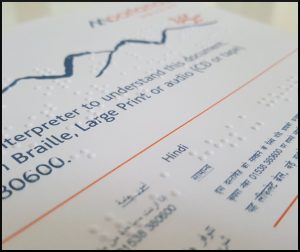2 June 2017
How to write an alternative formats statement
It may seem an odd question, but just how accessible is your statement about your document’s accessibility? We often find that document accessibility statements like ‘this information is available in alternative formats on request’ are in a tiny, hard-to-read font or colour, often hidden away at the back of the document – when they should be front and centre!
If you’ve already made the effort to produce your information in Braille, Large Print, Audio or another language, you obviously don’t need convincing about the importance and benefits of accessibility for your readers and organisation. So why hide your positive attitude to accessible information? Say it loud and proud!
To increase the likelihood that print-disabled customers (or indeed their friends or families) will see your accessibility statement, we recommend that you:
- Put your accessible information statement on the front page – or contents page – of your document
- Use minimum font size 16 for the statement, where possible
- Use a sans serif font (such as MS Word’s Arial, Calibri or Verdana)

Taking these simple steps creates a welcoming environment for your readers. By making it easier for people to ask for alternative formats, you also let people know that you’ve thought about their individual needs. And it gets your information out there.
If you’ve already produced documents that don’t include an accessible information statement, don’t worry! At A2i, we can produce Braille and/or Large Print labels and compliment slips which can be adapted for your document, but often state the following:
“This document is available in Braille, Audio, Large Print, and E-text formats. Please phone 01179 44 00 44 to request a copy.”
Finally, why not consider joining ‘Happy to Translate’ and telling people you are happy to translate your documents into alternative formats and languages? Happy to Translate is a not-for-profit membership organisation that promotes equal access to information and services for anyone facing language and communication barriers. By becoming a member, organisations can use the Happy to Translate logo on the front of their documents to quickly and easily communicate to readers that the document is available in other formats and languages. The Happy to Translate organisation provides other tools and processes to assist organisations to bridge the communication gap between service providers and service users. Find out more on the Happy to Translate website.